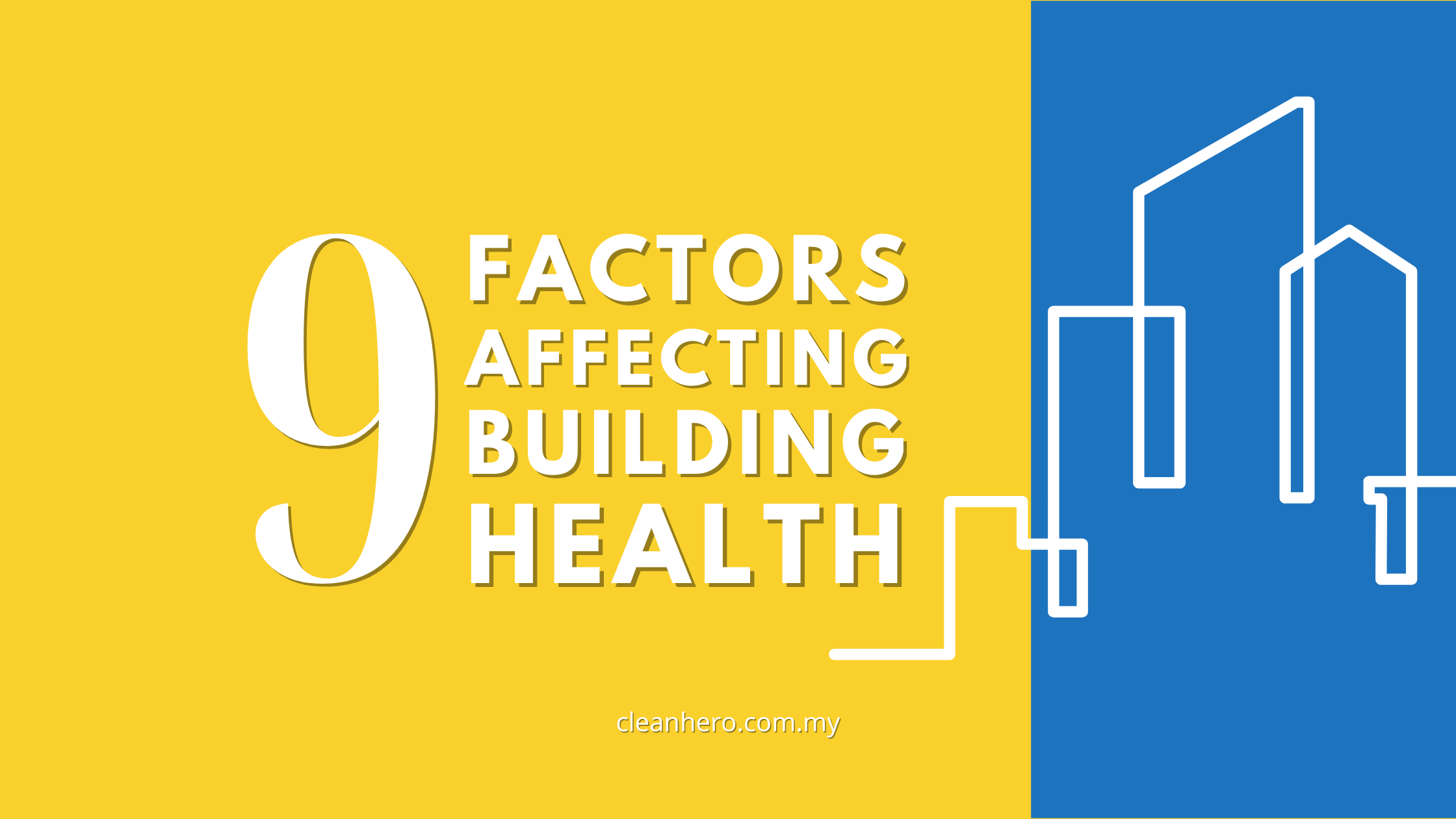9 Factors Affecting Building Health
A healthy building is one that provides a positive impact on its occupants’ mental and physical being. Additionally, excellent building health does not compromise the external environmental state. A healthy workspace plays a huge role in the employees’ wellbeing and productivity.
At CleanHero, we are committed to setting a clean and healthy indoor environment for our customers, one service at a time. We referred to and summarized Harvard’s Public Health Research on the 9 factors affecting building health.

Air quality
Harmful pollutants indoors affect the indoor air quality (IAQ). As we spend more hours indoors versus outdoors, our concerns should lie heavily towards the internal environment live in. Though we are learning about the effects of toxic cleaning chemicals, more than 80,000 chemicals are still commercially available. 85% of these chemicals have no health data.
High exposure to indoor pollutants is causing asthma, bronchitis, and allergies. These effects may occur at the moment of contact or years later. Furthermore, an increase in people experiencing the sick building syndrome (SBS) increases the rate of absenteeism at work. Thus negatively affecting productivity while increasing healthcare costs.
Ventilation
Proper ventilation allows fresh air to stabilize the pollutants in our indoor air. These pollutants include carbon dioxide and volatile organic compounds. Occupants reported stuffy and unpleasant feelings when in low ventilated buildings. Additionally, occupants experience headaches, nausea, shortness of breath, and more. These sick building syndromes (SBS) refers to the low ventilation-induced symptoms. Many studies show a positive correlation between the rate of air circulation and productivity & health.
Thermal health
Thermal health goes beyond comfort. As global warming issues rise, excessive temperature and humidity levels are affecting our health, and have even resulted in death in some cases. For example, a heatwave in France in 2003 killed nearly 15,000 people.
A study on workplace thermal conditions shows that when the heat, humidity, and ventilation are less than favourable, occupants experience watery eyes, headaches, and irritated throats. High temperature indoors triggers negative moods, respiratory symptoms, and fatigue. On another note, low temperature and low humidity encourage disease transmission. In school settings, students perform better in exams when there’s an increase of 1°C in the 20-25°C range.
Noise
One of the factors affecting building health is noise. Noise refers to any unwanted sounds. The generation of noise can happen both indoors and outdoors. Construction noise and the vacuum hum can disrupt our daily responsibilities. Hearing loss caused by noise leads to communication barriers, limit concentration and increase stress. High noise levels are associated with high blood pressure and hypertension.
In children, exposure to noise results in behavioral changes, hyperactivity, and noise annoyance. Noise annoyance, a form of psychological stress goes beyond irritation, discomfort, and stress. Moreover, adults experience lower physical activity levels when experiencing noise annoyance. In terms of performance, low concentration, memory recalls, work satisfaction, and production are the results of noise exposure.
WE REMOVE BACTERIA AND DEEPLY ROOTED DIRT FROM YOUR CARPET & UPHOLSTERY
EXPERIENCE THE DIFFERENCE OF A PROFESSIONAL DEEP CLEANING
WE REMOVE BACTERIA AND DEEPLY ROOTED DIRT FROM YOUR CARPET & UPHOLSTERY
EXPERIENCE THE DIFFERENCE OF A PROFESSIONAL DEEP CLEANING
Lighting and views
The human body synchronizes with the rise and fall of the sun. The fluctuations of night and day control the circadian system. This system is influenced by the timing, duration, and intensity of light exposures.
Our bodies’ circadian system regulates our immunity. Any changes to the circadian rhythm can cause fatigue, increase cancer risks, and develop sleep and mood disorders. Exposure to daylight through windows in the workplace improves employees’ mood and energy.
Water quality
As one of the factors of building health, water regulates body temperature, protects tissues, and encourages healthy waste removal. Drinking contaminated water is responsible for transmitting pathogens and over 850,000 deaths. As not everyone has access to clean water, contaminated water is a global concern. Contamination occurs through the wear and tear of service pipes, improper water treatments, and long storage periods.
Moisture
Common sources of moisture in buildings are flood, plumbing leaks, and poor insulation. Secondary sources include water vapor from showers and poorly vented kitchen. Excessive moisture causes mold growth, which can go unnoticed in carpets, walls, etc. The growth of molds will then cause bad odours and health effects such as asthma, eczema, and lung tumor development.
Dust and pests
Dust and pests harbours contaminants like viruses, lead and mold spores. Exposure to dust and pests can happen through inhalation, absorption, and ingestion. For indoor settings, the most common sources of dust and pests are dust mites, mice, cats, and dogs. Dust mites live in our furniture upholstery and they trigger asthma attacks. Pests like mice and rats release allergens in their urine. The dried urine will then cause allergic reactions. Furthermore, exposure to cockroach allergen puts humans at risk of hospitalization.
Though the use of pesticides can discourage the population of pests indoors, it brings another set of health problems. Certain chemicals in pesticides link to urinary tract infections, acute myelocytic leukemia, and thyroid diseases.
Safety and security
Maslow’s hierarchy of needs lists safety and security as one of the basic human needs. Locking our doors and setting up CCTVs are common practices nowadays to ensure our physical items are safe from robberies and damages. Being in a safe and secure building can also influence our mental and physical health.
When expecting threats, our bodies prepare to fight or flight. Stress-induced hormones like adrenaline flood our systems, increasing our blood pressure. Psychological stress suppresses immune function which increases the risk of autoimmune diseases. Additionally, high blood pressure increases the risk of hypertension and cardiovascular diseases. In terms of mental health, post-traumatic stress disorder, depression, and insomnia can occur.




